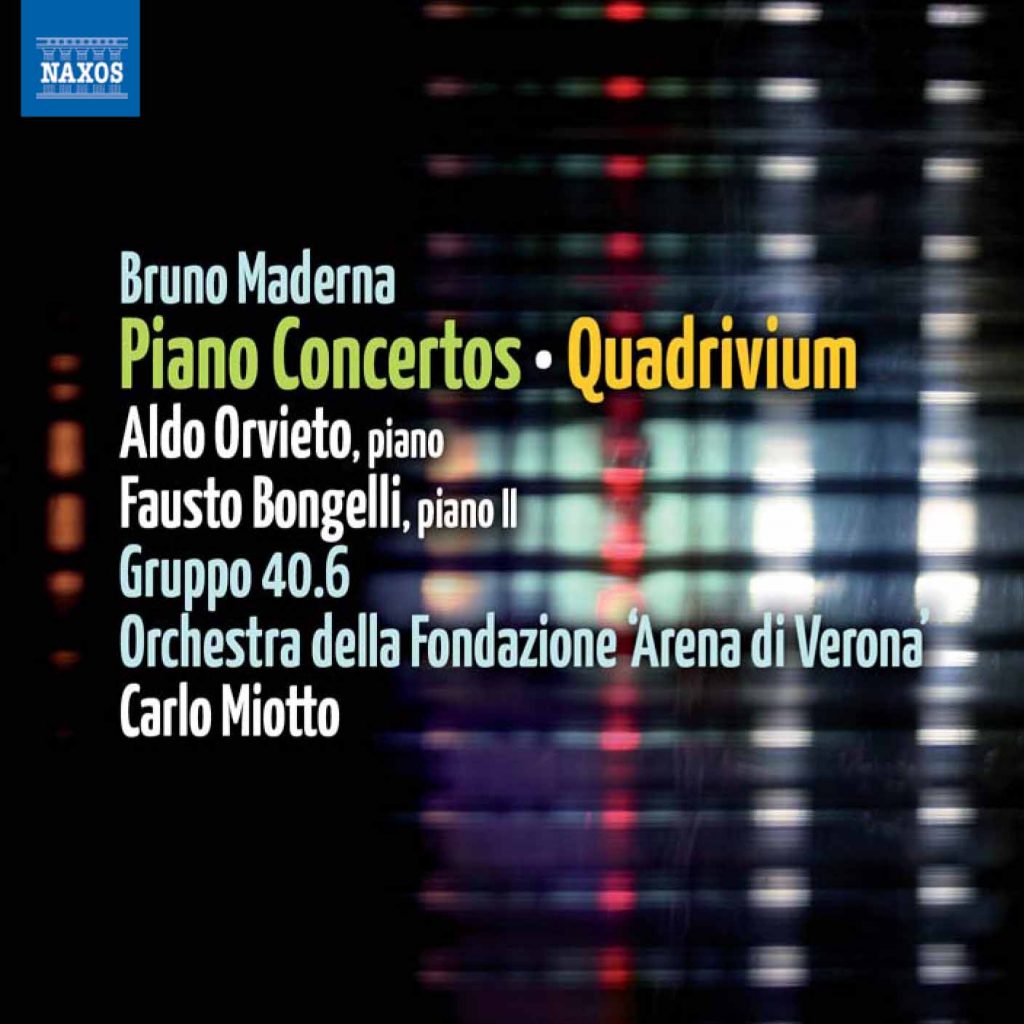
Bruno Maderna
Bruno Maderna (1920-1973)
Concerto for piano and orchestra (1942) • Piano Concerto (1942) – Reduction for two pianos
(1946) • Concerto for two pianos and percussion (1948) • Quadrivium (1969)
There is a meteor that orbits and occasionally blazes into view within the wide landscape of twentieth-century avantgarde music: Bruno Maderna. There is something unusual in the artistic fate of this figure, whose name is usually linked with those of the younger Italian composers Luciano Berio and Luigi Nono. A mysterious oblivion blurs the centrality and importance of his contribution to the growth of the young Italian school after his sudden death in 1973 at the age of 53.
In the 1950s Maderna had begun an international career as conductor, refined interpreter of twentiethcentury repertoire and tireless promoter of new works by young composers. This led him to the podium of the most important orchestras, first in Europe (Britain, Germany, Sweden, Belgium, Holland, Austria), then in the 1970s in the United States (Juilliard Ensemble, the orchestras of Chicago, Cleveland, Boston, Philadelphia, Miami, New York). From 1971-72 he was the director of the Berkshire Music Centre Tanglewood and in 1971 he took over the Orchestra Sinfonica RAI of Milan. His extensive conducting work most likely helped to boost his fame as a composer, partly because he thus avoided appearing to the musical world as a verbose exegete who
provided philosophical constructions to ‘explain’ his stylistic forms and methods (as was then so often the case). Instead he let the music speak for itself. In his work he continued to hark back to features of his early musical training and to the lessons of Gian Francesco Malipiero, adopting an attitude that looked both to ‘his’ older Venetian roots and the Gabrielis, but also to the Flemish
polyphonists. At the same time he displayed a boundless curiosity for the twelve-tone technique of Schoenberg and
Webern, not to mention the innovative electronic experimentation of those years.
Ever since his appearance in 1949 at the Ferienkurse in Darmstadt Maderna was an active protagonist of the contemporary artistic life. Nonetheless, his interest in (and active support of) the new directions of new music never saw him aligned with the more ‘ideological’ attitudes then emerging as the main trends. His way of standing aside from the pack and his entirely personal use of the stylistic
tools of the avant-garde are the most likely explanations for the inadequate assessment of his rôle as a composer at his death – at least until an important critic, Massimo Mila, in the early 1980s began to promote his work through a series of radio broadcasts and a book entitled Maderna musicista europeo (Maderna, a European musician).
Today, there is an increasing interest in the works of Maderna. Research has intensified and there are more frequent performances of his music, to the extent that we can talk of a sort of ‘Maderna Renaissance’. New aspects of his youthful writing with strong ties to the twentiethcentury European tradition have been brought to light by performances of two recently ‘rediscovered scores’ (or
lost early works): the Piano Concerto of 1942 (given its first performance in modern times at the VeronaContemporanea festival of the Fondazione Arena of Verona on 10th October 2009, from which this recording is taken) and the Requiem of 1946 (performed
at La Fenice in Venice on 19th November 2009).
The compositional path presented in this recording significantly outlines certain stages in Maderna’s compositional development: specifically for the piano, with the Concerto written when Maderna was little over twenty (available in two versions, one with orchestra and a reduction for two pianos) and his piece for two pianos and instruments of 1948; and finally a great leap into maturity with the monumental Quadrivium (1969), which emblematically represents one of the most significant stages in the composer’s last creative period.
The Piano concerto, the début work of a promising new graduate who had hoped to entrust it to Arturo Benedetti Michelangeli, suffered a fate similar to other works of those years, and it disappeared from circulation after a first performance on 22nd June 1942. There have been attempts to explain the neglect for the music of this period by the composer’s need to go further and to project his work towards the horizons of radical serialism and twelve-tone technique, inducing him to abandon the manuscripts of his early works on dusty bookshelves or archives. Yet this work, with its three movements following one another seamlessly and two slow movements framing the central pulsating allegro, is a veritable gem infused with an admirable sense of tension and breadth. The piano style, which is sometimes brilliant and sometimes contains elements of alienating lyrical writing, emerges
gradually from within the symphonic continuum, almost like an instrument’s tone emerging from within the orchestra. Here and there we find rhapsodic sketches, virtuoso elements, fleeting cadenzas. There’s a whole century that resurfaces, that was probably filtered by the teachings of Malipiero. Here we find a young man still immersed in an atmosphere of the mainstream twentieth
century, displaying an almost Ravelian taste in the outlines of the piano writing, with a look at Stravinsky, Bartók and Debussy and with a lyrical expansion that even remind us of Rachmaninov. While never betraying a hint of scholasticism, he admirably combines the poetic dimension with a sense of formal coherence.
